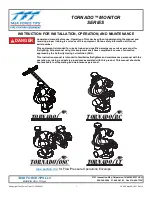
RP0169-2002
NACE International
5
should be properly rated and installed in accordance
with the manufacturer’s instructions.
4.3.7 River weights, pipeline anchors, and metallic
reinforcement in weight coatings should be electrically
isolated from the carrier pipe and designed and
installed so that coating damage does not occur and
the carrier pipe is not electrically shielded.
4.3.8 Metallic curb boxes and valve enclosures should
be designed, fabricated, and installed in such a manner
that electrical isolation from the piping system is
maintained.
4.3.9 Insulating spacing materials should be used
when it is intended to maintain electrical isolation
between a metallic wall sleeve and the pipe.
4.3.10
Underground
piping
systems
should
be
installed so that they are physically separated from all
foreign underground metallic structures at crossings
and parallel installations and in such a way that
electrical isolation could be maintained if desired.
4.3.11
Based on voltage rating of alternating current
(AC) transmission lines, adequate separation should
be
maintained
between
pipelines
and
electric
transmission tower footings, ground cables, and
counterpoise. Regardless of separation, consideration
should always be given to lightning and fault current
protection of pipeline(s) and personnel safety (see
NACE Standard RP0177
2
).
4.4 Electrical Continuity
4.4.1 Nonwelded pipe joints may not be electrically
continuous. Electrical continuity can be ensured by the
use of fittings manufactured for this purpose or by
bonding across and to the mechanical joints in an
effective manner.
4.5 Corrosion Control Test Stations
4.5.1 Test stations for potential, current, or resistance
measurements
should
be
provided
at
sufficient
locations to facilitate cathodic protection testing. Such
locations may include, but not be limited to, the
following:
4.5.1.1 Pipe casing installations,
4.5.1.2 Metallic structure crossings,
4.5.1.3 Isolating joints,
4.5.1.4 Waterway crossings,
4.5.1.5 Bridge crossings,
4.5.1.6 Valve stations,
4.5.1.7 Galvanic anode installations,
4.5.1.8 Road crossings,
4.5.1.9 Stray-current areas, and
4.5.1.10
Rectifier installations.
4.5.2 The span of pipe used for line current test
stations should exclude:
4.5.2.1 Foreign metallic structure crossings;
4.5.2.2 Lateral connections;
4.5.2.3 Mechanical couplings or connections such
as
screwed joints, transition pieces, valves,
flanges, anode or rectifier attachments, or metallic
bonds; and
4.5.2.4 Changes in pipe wall thickness and
diameter.
4.5.3 Attachment of Copper Test Lead Wires to Steel
and Other Ferrous Pipes
4.5.3.1 Test lead wires may be used both for
periodic testing and for current-carrying purposes.
As such, the wire/pipe attachment should be
mechanically strong and electrically conductive.
4.5.3.2 Methods of attaching wires to the pipe
include (a) thermit welding process, (b) soldering,
and (c) mechanical means.
4.5.3.3 Particular attention must be given to the
attachment method to avoid (a) damaging or
penetrating the pipe, (b) sensitizing or altering of
pipe properties, (c) weakening the test lead wire,
(d) damaging internal or external pipe coatings,
and (e) creating hazardous conditions in explosive
environments.
4.5.3.4 Attachment by mechanical means is the
least desirable method. Such a connection may
loosen, become highly resistant, or lose electrical
continuity.
4.5.3.5 The connection should be tested for
mechanical strength and electrical continuity. All
exposed portions of the connection should be
thoroughly cleaned of all welding slag, dirt, oils,
etc.; primed, if needed; and coated with materials
compatible with the cable insulation, pipe coating,
and environment.
4.5.4 Attachment of Aluminum Test Lead Wire to
Aluminum Pipes
4.5.4.1 Aluminum test lead wire, or aluminum
tabs attached to aluminum wire, may be welded to
aluminum
pipe using the tungsten inert-gas
shielded arc (TIG) or metal inert-gas shielded arc
(MIG) process.
Welded attachments should be
Summary of Contents for CP 1
Page 1: ...CP 1 Cathodic Protection Tester Course Manual February 2005 NACE International 2000 ...
Page 265: ......
Page 266: ......
Page 267: ......
Page 268: ......
Page 301: ...RP0169 2002 32 NACE International ISBN 1 57590 035 1 ...
Page 535: ...TM0101 2001 24 NACE International ISBN 1 57590 137 4 ...
















































